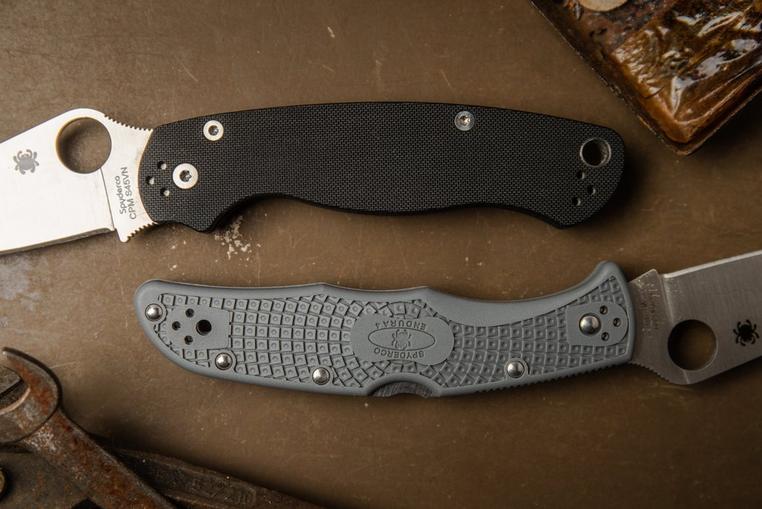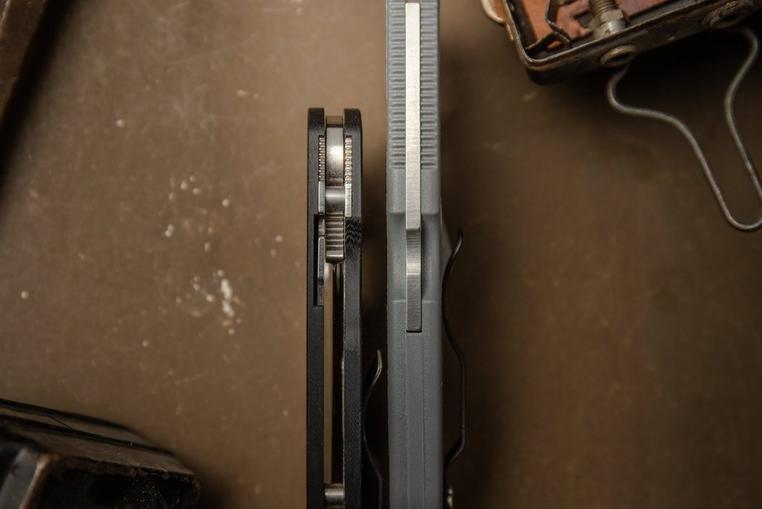Spyderco Endura 4 vs Spyderco Paramilitary 2
The Spyderco Paramilitary 2 vs. the Endura 4. Two large, popular EDC knives. But which of these two knives suits you best? We've made this side-by-side comparison so you can find out.
Multiple different versions of both knives have been introduced over the years. For this side-by-side comparison, we are looking at the standard models: the Spyderco Paramilitary 2 C81GP2 and the Spyderco Endura 4 C10FPGY.
The similarities between the Spyderco Endura 4 and the Spyderco Paramilitary 2
The biggest similarity is that they are both relatively large EDC knives. You use them for almost the same tasks, from fairly heavy cutting jobs such as opening boxes or cutting old paper into small pieces, to lighter tasks such as peeling an apple. Both knives have the well-known Spyderco thumb hole. They also have a pocket clip that you can attach in four different ways.
The differences between the Spyderco Endura 4 and Spyderco Paramilitary 2
Handle material
The most noticeable difference is the handles. The handle of the Endura 4 is made of FRN plastic (fibreglass-reinforced nylon). The Paramilitary 2 has a G10 handle. This is a fibreglass fabric with an epoxy base. Both materials are lightweight and seriously strong. They are waterproof, rugged, and not sensitive to differences in temperature. Despite the fact that they are two different materials, it's difficult to choose a favourite here. The relief on both handles is also different. The relief of the Endura 4 is fairly chunky, while the Paramilitary 2 has a subtle, yet still rough, relief. Both knives are comfortable to hold and have good grip.
Size
The Endura 4 measures 22.2 cm in its open position compared to the 21 cm of the Paramilitary 2. Both the handle and the blade of the Endura 4 are half a centimetre longer than those of the Paramilitary 2.
Blade and steel type
Another big difference is the types of steel used. The Paramilitary 2 has American CPM S45VN steel. The Endura 4 has Japanese VG-10 steel. In terms of corrosion resistance, these are almost equal. For hardness and sharpness retention, CPM S45VN steel beats VG-10 steel (with the hardening by Spyderco). The Endura 4 has a hardness of 58 HRC and the Paramilitary 2 has 60 HRC. Not a very big difference, but if you often use the knife for tasks like cutting cardboard boxes, the Paramilitary 2 will stay sharp longer. Of course, it depends on how often and how intensely you use the knife.
Furthermore, the blade of the Paramilitary 2 has a convex edge, which reduces the contact surface of the edge for excellent cutting capabilities. The Endura 4 has a straight edge that is more suitable for horizontal cutting movements. The Paramilitary 2 also has ribbed finger grooves on both the top and bottom of the blade. This allows you to hold the knife very close to the edge for more control in tasks that require precision. The Endura 4 only has a ribbed finger groove for your thumb at the top of the blade. The blade of the Endura 4 is 3 mm thick and the Paramilitary 2's blade is 4 mm. You won't notice any difference in terms of cutting ability.
Weight
Due to the differences in size and material, there is also a small difference in the weight of both knives. The Endura 4 weighs 95 grams and the Paramilitary 2 weighs 110 grams.
Country of origin
The Paramilitary 2 is one hundred percent made in the United States. The CPM S45VN steel is American, the G10 is American and the blade is assembled in America. The Endura 4 comes from Japan. The VG-10 is Japanese and the knife is also assembled in Japan. Apart from the material, there's nothing to indicate where the knives are made.
Locking mechanism
These two knives have different locking mechanisms. The Spyderco Paramilitary 2 has a compression lock. This is a sort of reversed liner lock. It clamps into a recess in the blade under the stop pin. Spyderco has both a left-handed and right-handed version of the Paramilitary 2 because the compression lock is an asymmetrical design and cannot be used with both hands. The Endura 4 has a back lock. This is a spring that runs over the spine of the knife. This spring falls into the lock behind the hinged point of the blade when the knife is opened. There is a recess in the back of the handle where the spring can be pressed to unlock the blade. This lock is suitable for both left-handed and right-handed use because of the symmetrical design.
Both mechanisms are designed by Spyderco and are located in the spine of the handle. A small but not unimportant difference is that the Paramilitary 2 opens slightly more smoothly than the Endura 4. This is because the back lock constantly presses on the blade when opening. There is less force pressing on the blade of the Paramilitary 2 with its compression lock design. Another big advantage is that you can easily close the Paramilitary 2's compression lock by holding the back of the handle with your fingertips and pressing the compression lock with your index finger. This keeps your fingers out of the path of the knife's edge when you fold it in.
Lanyard hole
A small but significant difference is the lanyard hole. They are both located on the back of the handle. The lanyard hole of the Endura 4 is more in the middle, but the main difference is the diameter. The lanyard hole of the Endura 4 is 4 mm in diameter and the lanyard hole of the Paramilitary 2 is a whopping 7 mm in diameter.
Which knife will you choose?
In terms of functionality, there is little difference between the knives. The main differences are the materials used and the locking mechanisms. Are you looking for an EDC knife with a better-than-average type of steel, very good ergonomics and lots of functionality, where price doesn't matter too much? Then the Paramilitary 2 is the best choice. However, you can save yourself some pennies and get a knife that may be made of a more budget-friendly material, but can easily handle the same tasks and is also slightly lighter. Whichever knife you choose, though, you'll be getting plenty of bang for your buck.











